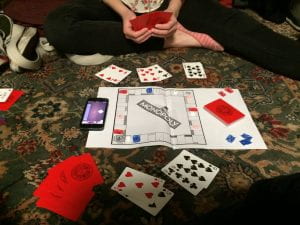Artist Statement:
The concept of my game Support was to be a game that could simulate a conversation with a loved one who was experiencing depression. The inspiration from this game came from games talked about in class/readings that focused on real issues, like September 12th or the McDonald’s Videogame, but primarily Depression Quest. I liked how the game put people in the shoes of a person going through life with Depression, and especially liked how the more depressed the player was, more options would become unclickable but still remain visible. I wanted to make a game where the player’s choices aren’t restricted, but they want to consider what they’re going to say since they aren’t sure how their loved one will react. I wanted to evoke feelings of concern and care, but also uneasiness and uncertainty.
If I were to put the game on the Schrank Avant-Garde diagram I would put it in the upper right hand side of the Emancipation square. I feel the game is decently political in it’s subject matter, while also allowing players to control the narrative through their actions to a degree. The game was more formal than radical, as the player did have control and weren’t just witnessing the game happening around them. But it did somewhat restrict their options to what was provided.
Documentation:
Game: I was going to put in pictures of the game being played but I instead am going to send the game itself. HTML files are not allowed to be posted on the blog so I shall email it after this is published.
The first playtest went smoothly. The player thought the intro I had written provided good context and they felt that it did a good job of putting them in the position of being the significant other. I saw that they were taking their time with decisions and weighing the potential outcomes, which made me very happy as that was an experience I really wanted players to have. When he finished I asked what he was feeling while playing. He said he felt bad/concern and was also worried when he felt like there was no good option, which was decently often. The game made him think of love, depression, not wanting to leave this special person, but also felt a bit uncomfortable. He didn’t have much criticism, except for the fact that there were some typo. This session was very satisfying to me as not only did he enjoy the game but all the goals I wanted to reach were hit. After that I fixed up the typos and added in more observations of the loved one to go along with what they are saying. My other playtests went smoothly as well, with the players all feeling the uneasiness and concern I wanted to be achieved. I thought about making the game a bit longer, but the playtesters that I had play the game felt what I wanted them to experience, so I left it as is. Over the summer I may go back in and work on this project a bit more, and maybe make it span over multiples days.

